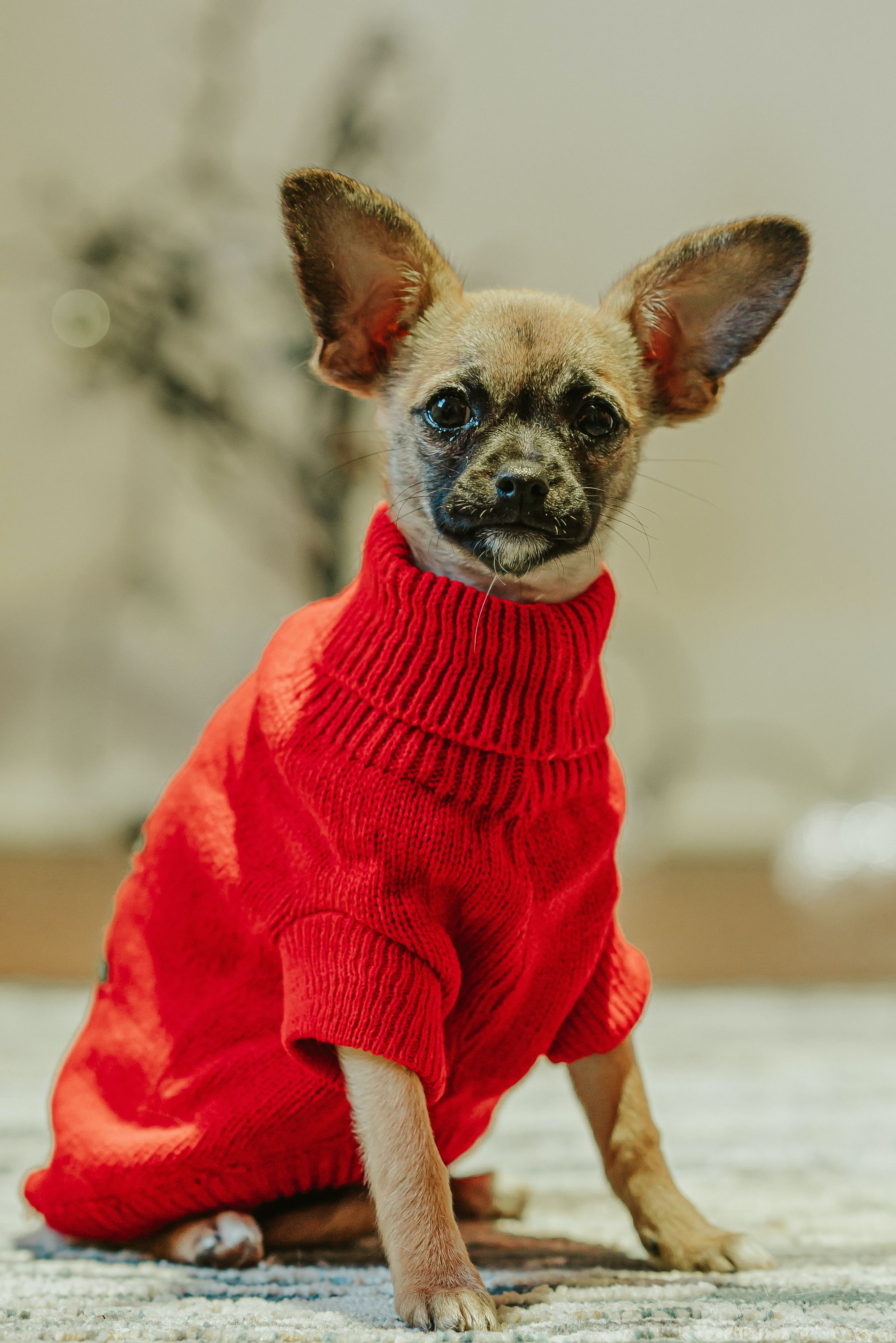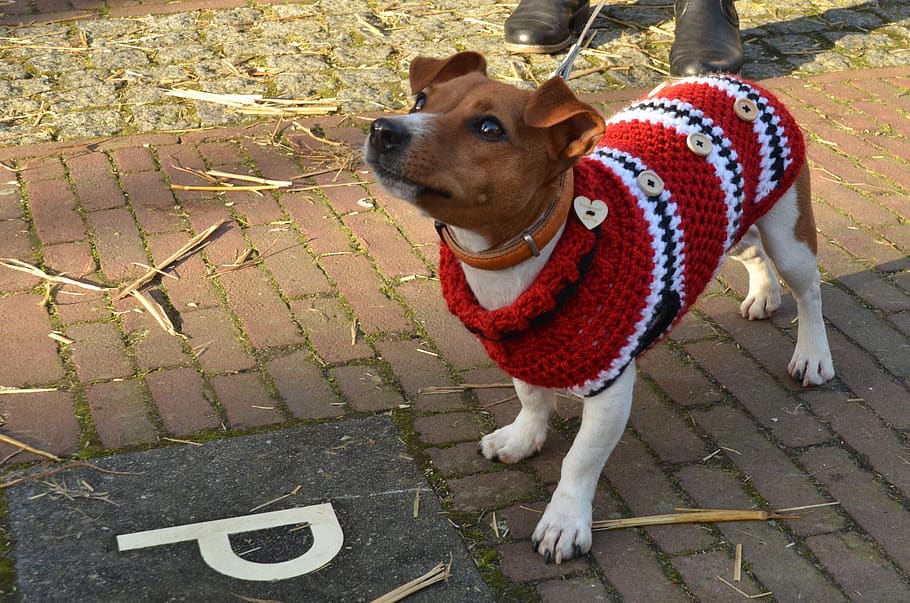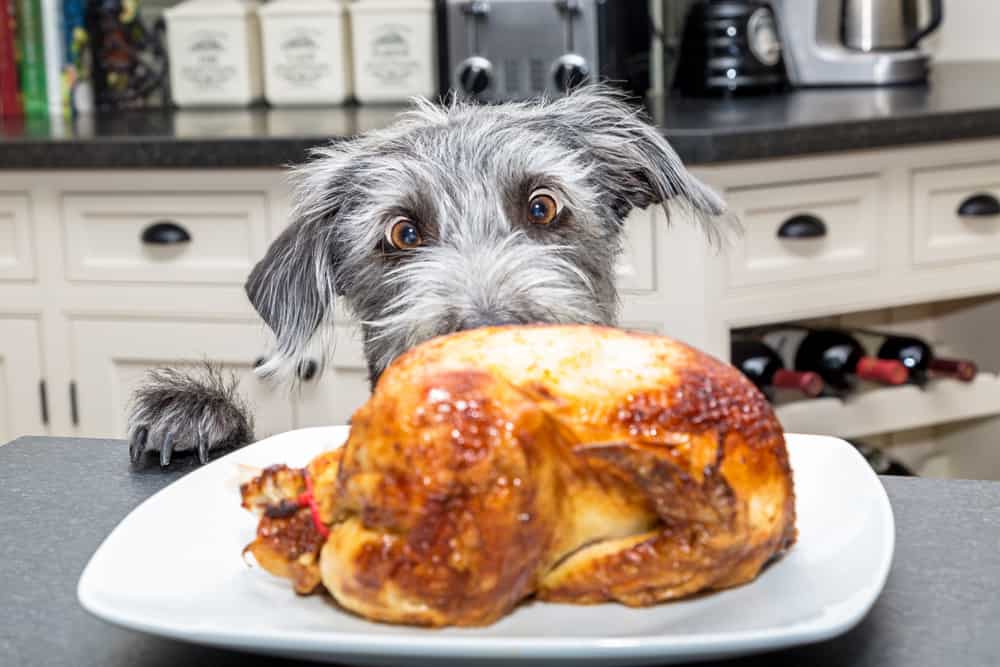Properly measuring a dog for clothing is essential to ensure a comfortable and well-fitting outfit. Whether you're looking to keep your furry friend warm during colder seasons or dressing them up for a special occasion, accurate measurements are crucial. By measuring your dog correctly, you can find clothing that fits well and allows for easy movement.
To measure a dog for clothing, you'll need a few tools handy. These include a flexible measuring tape, which is crucial for taking precise measurements, and a notepad and pen to record the measurements. It's important to have a treat or a toy to keep your dog distracted and cooperative during the process.
Step-by-step measuring instructions for your dog's clothing are as follows:
- Get the Dog's Neck Measurement: Measure around the base of your dog's neck, where their collar would typically sit.
- Measure the Dog's Chest: Wrap the measuring tape around your dog's chest, right behind their front legs.
- Determine the Dog's Length: Measure from the base of the neck to the base of the tail, along the dog's spine.
- Measure the Dog's Girth: Wrap the measuring tape around the widest part of your dog's ribcage.
- Measure the Dog's Leg Length: Measure from the base of the leg to the ankle joint.
When measuring your dog for clothing, there are several considerations to keep in mind. Firstly, consider your dog's breed and body shape, as different breeds may require specific measurements. Secondly, prioritize your dog's comfort and mobility when choosing clothing, ensuring they have the freedom to move and play. Lastly, take into account the fabric and design of the clothing, selecting materials that are comfortable and suitable for your dog's needs.
To ensure accurate measurements, it's important to follow a few tips. Make sure the measuring tape is not too tight or too loose, allowing for a comfortable fit. Take multiple measurements of each area to ensure accuracy, and record the measurements carefully for reference. Avoid measuring over thick fur, as this can result in inaccurate measurements.
By understanding how to measure a dog for clothing correctly and considering essential factors, you can find the perfect fit for your furry companion while making sure they look stylish and feel comfortable.
Key takeaways:
- Measure the dog's neck: Start by measuring the circumference of the dog's neck to ensure a properly fitting collar or clothing item.
- Measure the dog's chest: Measure the widest part of the dog's chest to determine the appropriate size for shirts, sweaters, and other clothing items.
- Consider the dog's breed and body shape: Different dog breeds have different body shapes, so take this into consideration when measuring for clothing to ensure a comfortable and proper fit.
Why Measure a Dog for Clothing?
Measuring a dog for clothing is important to ensure the perfect fit and comfort for your furry companion. It helps prevent discomfort, restriction of movement, and potential injury. By measuring your dog, you can find the right size and style of clothing that suits their unique body shape and size. Whether it's a cozy sweater for colder weather or a protective jacket for outdoor adventures, measuring your dog for clothing is essential to keep them happy, healthy, and stylish. So, why measure a dog for clothing? Because it prioritizes their well-being and enhances their overall comfort and style.
What Tools Do You Need to Measure a Dog?
To accurately measure your dog for clothing, you will need a few essential tools. The following list, using HTML tags for easy reference, highlights the necessary items:
- Measuring tape: A flexible measuring tape is crucial to obtaining precise measurements of your dog's various body parts.
- Notepad and pen: Keeping notes of the measurements will be beneficial when selecting the appropriate size of clothing.
- Treats or toys: Utilizing treats or toys can serve as helpful distractions to keep your dog calm and cooperative throughout the measuring process.
- A helper: Having someone assist you can make measuring your dog easier, particularly if your dog tends to wriggle around.
With the aid of these tools, you will be well-prepared to measure your dog accurately and ensure a comfortable fit when purchasing clothing.

Step-by-Step Guide: How to Measure a Dog for Clothing
Getting the perfect fit for your furry friend's clothing isn't always easy, but with our step-by-step guide, measuring your dog for clothing becomes a breeze. From the dog's neck measurement to determining their girth and leg length, we'll walk you through each essential step. Say goodbye to ill-fitting outfits and hello to stylish and comfortable attire for your beloved canine companion. Let's dive into the details and ensure your pup looks and feels their best with these precise measurements.
Step 1: Get the Dog's Neck Measurement
To measure a dog's neck for clothing, follow these steps:
- Step 1: Get the Dog's Neck Measurement. Using a flexible measuring tape, gently wrap it around the base of the dog's neck.
- Make sure the tape is snug but not tight, and record the measurement.
- Take note of any fur or collar that might affect the fit of the clothing.
Pro-tip: If your dog falls between sizes, always opt for the larger size for a more comfortable fit.
Step 2: Measure the Dog's Chest
To measure a dog's chest for clothing, follow these steps:
- Place the measuring tape just behind the front legs, at the widest part of the chest.
- Wrap the tape snugly around the chest, but not too tight. This is step 2: Measure the Dog's Chest.
- Note down the measurement in inches or centimeters.
When measuring a dog's chest for clothing, it's important to consider the following:
- Different dog breeds and body shapes may have different chest sizes, so measure accordingly.
- Ensure the dog's comfort and mobility by choosing clothing that allows for proper movement.
- Consider the fabric and design of the clothing to ensure a proper fit and functionality.
To obtain accurate measurements, follow these tips:
- Use a flexible measuring tape to easily wrap around the chest.
- Have someone assist you in holding the dog still and maintaining a proper posture during measurement.
- Take multiple measurements to ensure consistency.
Avoid these common mistakes when measuring a dog's chest:
- Measuring too loosely or too tightly, which can result in an ill-fitting garment.
- Confusing the chest measurement with other measurements such as the neck or length.
- Not considering the dog's comfort and mobility when selecting clothing based solely on measurements.
By following these steps and considerations, you can accurately measure a dog's chest for clothing and choose the perfect fit for their comfort and style.

Step 3: Determine the Dog's Length
To determine the length of your dog for clothing, follow these steps:
- Place your dog in a standing position on a flat surface.
- Start at the base of the neck and measure along the spine to the base of the tail.
- Ensure the measuring tape follows the contour of your dog's back for an accurate measurement.
- Note down the measurement in inches or centimeters.
- Use this measurement when looking for clothing sizes to ensure the perfect fit.
Pro-tip: If your dog is between sizes, it's usually best to go for the larger size to ensure comfort and freedom of movement.
Step 4: Measure the Dog's Girth
To accurately measure a dog's girth for clothing, follow these steps:
- Position the measuring tape behind the dog's front legs.
- Wrap the tape snugly around the widest part of the chest, just behind the front legs.
- Ensure that the tape is parallel to the ground and not too tight.
- Measure the dog's girth by taking note of the measurement in inches or centimeters.
- Repeat the process a few times to ensure accuracy.
Considering the dog's girth is important when measuring for clothing as this determines the size and fit. It ensures that the clothing is not too tight or loose, allowing the dog to move comfortably. It's crucial to consider the fabric and design of the clothing, as well as the dog's breed and body shape, to ensure the best fit and functionality.
Step 5: Measure the Dog's Leg Length
To measure a dog's leg length for clothing, follow these steps:
- Ensure that the dog is standing on all fours.
- Locate the highest point of the dog's shoulder joint.
- Place one end of the measuring tape on the shoulder joint.
- Extend the measuring tape down the front leg, following the natural curve of the leg.
- Measure the Dog's Leg Length: Note the measurement where the tape reaches the lowest point of the paw.
Pro tip: It's essential to measure each leg individually, as dogs can have slightly different leg lengths. Always measure the longer leg for a better fit and comfort.
What Should You Consider When Measuring a Dog for Clothing?
When it comes to finding the perfect clothing for your furry friend, there are a few important factors to consider. In this section, we'll dive into what you should keep in mind when measuring a dog for clothing. From considering their breed and body shape to ensuring their comfort and mobility, we'll explore the key elements that will help you find the right fit. We'll discuss why the fabric and design of the clothing are crucial for your pup's ultimate satisfaction. So, let's get started on the journey to finding the ideal attire for your adorable companion!
Consideration 1: Dog Breed and Body Shape
When considering dog breed and body shape while measuring a dog for clothing, it is important to keep the following factors in mind:
- Consideration 1: Size - Different breeds have varying body sizes and proportions. It is important to ensure that the clothing you choose is suitable for your dog's size.
- Consideration 2: Body Shape - Dogs can have different body shapes, such as long and slim, muscular, or barrel-chested. It is crucial to make note of your dog's specific body shape in order to select clothes that fit properly.
- Consideration 3: Mobility - It is essential to consider your dog's range of motion and any restrictions they may have. Therefore, it is important to choose clothing that allows them to move comfortably.
- Consideration 4: Breed-Specific Considerations - Some dog breeds have specific characteristics that may affect clothing choices. For example, short-haired breeds may require extra insulation in colder weather.
Consideration 2: Dog's Comfort and Mobility
When measuring a dog for clothing, it's essential to take into consideration the dog's comfort and mobility. Here are some factors to keep in mind for the best fit and style:
1. Size and fit: Give priority to clothing that allows freedom of movement and doesn't restrict the dog's natural range of motion. This ensures that the dog can move comfortably.
2. Material: Opt for lightweight and breathable fabrics that won't cause any discomfort or overheating for your furry friend. It is important to select materials that contribute to the dog's comfort.
3. Design: Avoid clothes with excessive embellishments, zippers, or buttons that could potentially rub against the dog's skin or get tangled in their fur. Prioritize designs that prioritize the dog's comfort and mobility.
4. Ease of movement: Consider clothing that doesn't cover the dog's joints or hinder their ability to walk, run, or go to the bathroom. This ensures that the dog can move freely without any hindrance.
By taking these aspects into consideration, you can ensure that the clothing you choose not only provides style but also offers maximum comfort and mobility for your furry friend.

Consideration 3: Fabric and Design of the Clothing
When considering the fabric and design of clothing for your dog, it is important to take into account a few key factors. First and foremost, comfort should be a top priority. Opt for fabrics that are soft, breathable, and non-restrictive, allowing your dog to move freely.
Additionally, it is crucial to think about weather-appropriate clothing. Choose materials that can keep your dog warm in colder temperatures and provide protection from the sun in hotter climates. Durability is another essential factor to consider. Select fabrics that are durable and can withstand your dog's activities and potential rough play. Moreover, it is crucial to choose clothing that is easy to clean. Look for machine-washable fabrics or ones that can easily be wiped clean to maintain hygiene and cleanliness.
Lastly, when it comes to design, make sure the clothing does not hinder your dog's movement or cover essential areas like the eyes, ears, or tail. By taking all of these factors into consideration, you can select clothing that not only looks great but also ensures your furry friend's comfort and safety.
Tips for Accurate Measurements
When measuring a dog for clothing, it's important to follow these tips for accurate measurements to ensure a proper fit. Here are some
- Measure the neck: Place the measuring tape around the base of the neck, where the collar would sit.
- Measure the chest: Wrap the measuring tape around the widest part of the chest, just behind the front legs.
- Measure the length: Start from the base of the neck and measure along the spine to the base of the tail.
- Measure the girth: Wrap the measuring tape around the widest part of the belly.
Following these steps will help you get the right measurements and select the perfect size for your furry friend.
Common Mistakes to Avoid
When measuring a dog for clothing, it's crucial to avoid common mistakes to ensure well-fitting outfits. Here are some errors that you should steer clear of:
- Failure to measure at the widest part of the chest: This can result in a tight fit that limits your dog's movement.
- Disregarding the neck measurement: A collar that is too tight can cause discomfort for your furry companion.
- Omitting the length measurement: An outfit that is either too long or too short can hinder your dog's mobility.
- Not taking into account the unique proportions of the breed: Different breeds have distinct body shapes, so it's important to choose clothing that suits their specific needs.
Remember, accurate measurements are essential to finding the perfect fit for your pooch!
Fact: Did you know? The world record for the largest dog ever recorded was an English Mastiff named Zorba, weighing in at a remarkable 343 pounds!

Some Facts About How To Measure a Dog for Clothing:
✅ Different types of clothing fit differently, so using weight as a measurement is not accurate. (Source: Our Team)
✅ To properly measure your dog for clothing, harnesses, muzzles, and other gear, start at the base of the neck and measure chest girth, neck girth, and shoulder blade size. (Source: Our Team)
✅ Body shape should also be considered when choosing outdoor gear for your dog. (Source: Our Team)
✅ Use a soft measuring tape to measure your dog's size, or alternatively, use string and a flat ruler. (Source: Our Team)
✅ It is important to measure in a calm environment with your dog standing, and it is advised to measure twice for accuracy. (Source: Our Team)
Frequently Asked Questions
- How do I measure my dog for clothing?
- To measure your dog for clothing, start at the base of the neck and use a soft measuring tape to get the chest girth, neck girth, and size of the shoulder blades. Consider your dog's body shape when choosing outdoor gear, as not every style is suited for every body type.
- What supplies do I need to measure my dog for clothing?
- You will need a soft measuring tape. If you don't have one, you can use string and a flat ruler, but be sure to triple-check your measurements for accuracy.
- How should I measure my dog's chest girth?
- Measure the chest girth by wrapping the measuring tape around the largest part of your dog's rib cage, just behind the front legs. Use the "two-finger rule" to ensure the right amount of snugness. If your dog is between sizes, choose the larger size.
- How do I measure my dog's neck girth?
- Measure the neck girth by measuring the circumference of your dog's neck, typically where the collar sits. Measure from the withers to the top of the chest and then all the way around the neck. Use the "two-finger rule" for an excellent fit. If your dog is between sizes, choose the larger size.
- Can I use a regular tape measure to measure my dog for clothing
- Yes, you can use a soft tape measure or string and a flat ruler to measure your dog. Just make sure to triple-check your measurements for accuracy.
- What should I do if my dog is between sizes when measuring for clothing?
- If your dog is between sizes, it is recommended to choose the larger size. This ensures a comfortable fit, and you can always adjust the clothing using adjustable straps or closures.






